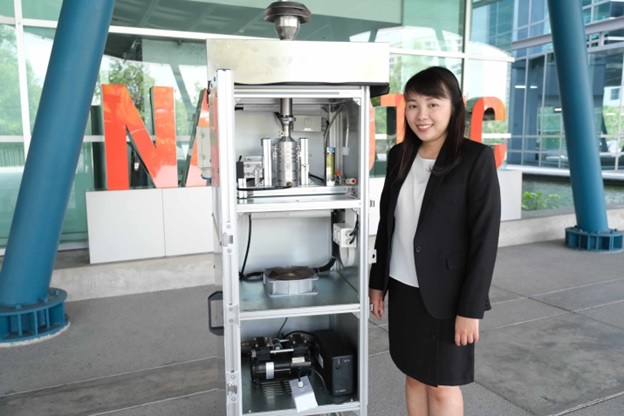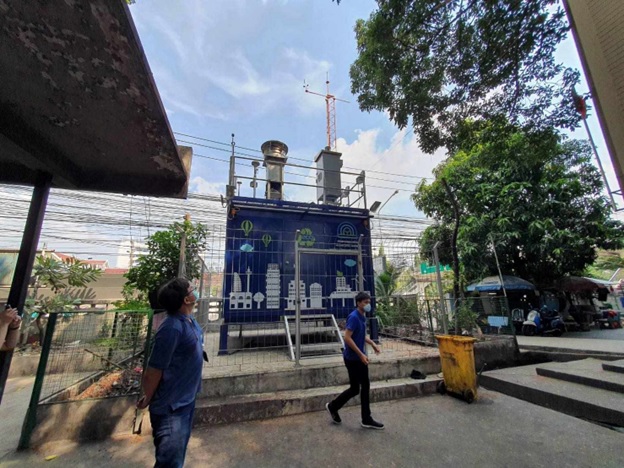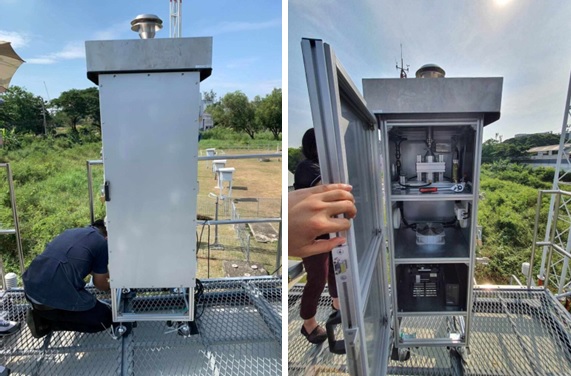As particulate pollution has been made a national agenda, a research team at NANOTEC-NSTDA developed NanoSampler, an air sampler for collecting various sizes of particulate matters (PMs). The device was employed to study the size distribution and chemical compositions of PMs in three locations in Bangkok, namely Aree, Bang Na and Din Daeng. The study results indicate that vehicle exhaust is the main contributor of PM2.5.

Dr. Rattaporn Saenmuangchin, a researcher of NANOTEC Nanocharacterization Research Team said that following the cabinet resolution making PM2.5 a national agenda in 2019, the Pollution Control Department has formulated an action plan to solve particulate pollution.
NANOTEC principal researcher Dr. Wiyong Kangwansupamonkon led a project to study PM2.5 in Bangkok. Funded by the National Research Council of Thailand, the project’s objective was to determine the size distribution and the chemical composition of particles. Data and results of the study would provide evidence to support the development of additional measures to increase area-based management efficiency, prevent and reduce pollution at the source and improve pollution management efficiency.

“In this project, PMs were collected at three PCD meteorological stations located in Aree, Din Daeng and Bang Na by using a device called NanoSampler first developed and reported by Furuuchi et al. (Furuuchi et al., Aerosol and Air Quality Research, 10: 185–192, 2010). This equipment can collect and separate particles of six sizes, namely PM0.1, PM0.1-0.5, PM0.5-1, PM1-2.5, PM2.5-10, and PM>10, making it more powerful than most air samplers on the market which collect only one particle size,” Dr. Rattaporn explained.

NanoSampler is designed to draw ambient air at a flow rate of 40 L/min. At each site, air samples were taken 40 times, each over a 24-hour period, throughout 2021. The analysis revealed that high particulate matter concentrations, 80-180 μg/m3, occurred from January to March. Low concentrations, 20-85 μg/m3, were recorded during April to September and rose to 40-190 μg/m3 during October to December. The highest concentrations found in all locations belongs to PM0.5-1 and PM2.5-10. Finest particles PM0.1 were found at the highest fraction in all sites throughout the year.
The highest total carbon (TC) concentration was found in PM0.5-1.0, and the lowest in PM>10. The levels of total carbon for each particle size are consistent across all three locations, and organic carbon (OC) is present at higher concentration than elemental carbon (EC) in all particle sizes. High carbon levels were found during January to March and low levels were found in April to July. In term of locations, Din Daeng has the highest OC and EC, mainly from combustion and secondary particulate matters.
Analysis of water-soluble inorganic species concentrations revealed that PM0.1, PM0.5-1 and PM1-2.5 contain high level of sulfate ion (SO42–), whereas nitrate ion (NO3–) was found at high concentrations in PM2.5-10 and PM>10. Both sulfate and nitrate are originated from vehicle and secondary particulate matters. Heavy metals were found at lower levels than TC and water-soluble inorganic species in all particle sizes. Fe, Na, Mg, Al and K - contributed by traffic, industry, soil dust, road dust and biomass burning - were present at high concentrations in all three locations.
The main source of PM2.5 is identified to be vehicle exhaust (48%), followed by secondary particulate matters, outdoor burning, factories and road dust. Vehicle emissions are also the main source of finest particles PM0.1 (65%) and fine particles PM0.5-2.5 (41%), whereas construction is the main source of coarse particles PM2.5-10 (50%).
“This study uncovered in-depth data that can be used by policymakers to design public policies and by health authorities to investigate health impacts of particulate matters,” Dr. Rattaporn concluded.
